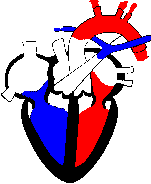A number of doctors believe that cardiac auscultation is obsolete and should be replaced by echocardiography. We even met a few cardiologists who have no stethoscope in the pocket of their blouse. This is obviously a mistake because the discovery of an asymptomatic breath during a complete physical examination may lead to discovering a serious organic disease or be an important diagnostic point in the exploration of a fever or systemic disease.
Recall that there is no correlation between the intensity of the blast and the severity of the underlying disease.
INORGANIC BREATH:
The breath can be inorganic, ie as echocardiography do discover any valvular or myocardial abnormalities.
In this case, the breath can be systolic or continuous, but never diastolic. It may be totally innocent, adolescents, pregnant women or patients with chest deformity, not even a flat back.
It may correspond to a cardiac hyperkinesia and in this case the patient is tachycardia, with increased systolic pressure. The first instinct is to check for anemia and dose thyroid hormones, looking for hyperthyroidism. Other causes of hyperdébit are much rarer. Include arteriovenous fistulas especially in dialysis, liver angiomatosis especially in hereditary telangiectasia Rendu Osler, Paget’s disease.
VALVULAR BENIGN ISOLATED:
The breath is an isolated mild valvular disease, it is the case of two frequent pathologies.
In young women, is mentioned first mitral valve prolapse (or Barlow’s disease), the prevalence can reach 10% of young women in some series. The breath can dominate the mitral valve or the side-to-left sternal region. It is systolic, preceded by a click mésosystolique and often increases in standing position. Ultrasound shows the ballooning of one or both mitral valves. It is important to recognize that this disease usually remains asymptomatic and benign but runs the risk of breaking rope and especially of infective endocarditis. As with any organic valvular disease it is important to regulate dental, endoscopy, minor surgery, with antibiotics.
In non-allergic patients with penicillin, it is advisable amoxicillin 3 g / day for 48 hours, beginning two hours before the procedure).
In the elderly, aortic systolic murmur at home, or apical, or heard in any precordial area (breath scarf) is often a trivial aortic atheroma and ultrasound only find some valvular alterations more or less calcified ( sometimes difficult to distinguish vegetation endocarditis).
VALVULAR MODERATE LEFT:
The breath is a left valve disease that is not hemodynamically significant, but reflects a systemic disease that will have to take charge.
Breath in the aortic position:
In the aortic position, it is a diastolic murmur of aortic insufficiency and the whole problem is not to disregard the diastolic murmur discrete lateral-left sternal.
The widening of the differential blood pressure is an additional argument in doubtful cases, before the ultrasound comes to confirm and quantify aortic regurgitation.
The fear before the discovery of aortic insufficiency is not to disregard endocarditis Osler. So we do control the thermal curve and inflammatory proteins is checked (in principle no infective endocarditis without increased CRP).
Blood cultures and the presence of vegetation ultrasound will confirm the diagnosis.
For treatment, see Chapter unexplained prolonged fever.
We must also look at the interrogation chest pain episode, a former, and in this case think of the dissection (see Chest pain).
Once eliminated these emergencies, we must always look for:
– Two birth defects, the bicuspid valve, and annuloaortic ectasia with or without Marfan syndrome (Arachnodactyly, laxity, multiple hernias, crystalline subluxation);
– Two chronic inflammatory rheumatism: ankylosing spondylitis (aortic regurgitation is present in 3% of cases) and more rarely rheumatoid arthritis;
– Two autoimmune diseases with antinuclear antibodies and / or antiphospholipid antibodies: systemic lupus erythematosus and antiphospholipid syndrome;
– Two rare systemic diseases can be complicated by aortic insufficiency and vasculitis
: Relapsing polychondritis (examine the cartilage of the ears and nose) and Cogan’s syndrome (there are normally hearing loss);
– Takayasu’s arteritis (in a young woman with arterial stenoses, in the absence of vascular risk factors, elevated ESR and inflammatory proteins).
Breath in the mitral position:
In the mitral position, it is usually mitral insufficiency. We must first ensure that it does not correspond to a heart failure (study of left ventricular function by ultrasound, dosage of Brain Natriuretic Peptide) or obstructive hypertrophic cardiomyopathy.
If not, look for an immune dysfunction diseases (systemic lupus erythematosus, antiphospholipid syndrome, Takayasu arteritis, Behcet’s disease) or hypereosinophilic heart disease. In this case, the blood picture shows more than 1500 eosinophils / mm3 and ultrasound shows retraction of pillars ropes or mitral, possibly associated with an intra-ventricular thrombus.
VALVULAR SEVERE LEFT:
The breath is severe valvular left and the problem is different in the aortic position and in the mitral position.
Breath in the aortic position:
In the aortic position, there is a blast aortic stenosis, and it is the ultrasound will quantify trans-orificial pressure gradient and the valve area (indication procedure below 0.5 cm2 / m2 body surface area). This valve disease will worsen inexorably.
Breath in the mitral position:
In the mitral position, it is often a systolic murmur of mitral regurgitation by breaking rope displayed in ultrasound. In this case, it is common after a transitional dyspnea left ventricle adapts to mitral regurgitation, and then we can postpone the mitral valve repair for years.
BLOWN FROM CAVITIES STRAIGHT:
This is usually a systolic murmur left latérosternal, located high enough, and the first cause to look for is pulmonary hypertension, especially if there is a B2 glow. In patients younger that breath can be a congenital narrowing of the pulmonary valve unrecognized during childhood.
In xiphoid position, breath can match tricuspid insufficiency, and in this case, the breath frankly increases inspiration.This is most often a functional tricuspid regurgitation associated with right heart failure, but we must always think of the tricuspid endocarditis.
If it is a breath or rather a diastolic rumble, it must evoke the carcinoid syndrome (think assaying urinary acid 5 hydroxyindolacetic and chromogramine serum A).


Leave a Reply